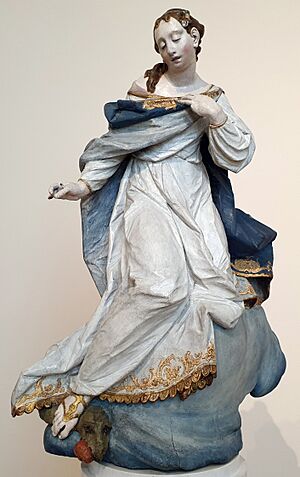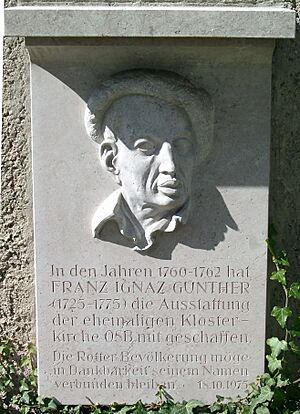Ignaz Günther facts for kids

Ignaz Günther (born November 22, 1725 – died June 27, 1775) was a famous German sculptor. He was also a skilled woodcarver. His art style was part of the Bavarian Rococo period. This style is known for being very decorative and fancy.
Ignaz was born in a town called Altmannstein. He learned his first art skills from his father. Later, from 1743 to 1750, he studied in Munich. His teacher there was a court sculptor named Johann Baptist Straub.
After his studies, Ignaz traveled a lot. These travels, called Wanderjahre, helped him learn even more. He visited cities like Salzburg, Olmütz, Vienna, and Mannheim. In Mannheim, he studied with Paul Egell from 1751 to 1752. From May to October 1753, he attended the Vienna Academy of Fine Arts. He even won the yearly student competition there!
In 1754, Ignaz Günther opened his own art workshop in Munich. He stayed there and worked until he passed away in 1775. He is most famous for the beautiful artworks he created for churches. Many of his best pieces are altars.
A special wooden crucifix made by Günther was given as a gift. It was presented to Pope Benedict XVI on his 85th birthday in 2012. The Pope was also from Bavaria, just like Günther.
Famous Artworks
Ignaz Günther created many amazing sculptures. Most of his work can be found in churches across Bavaria. Here are some of his important pieces:
- Altmannstein—Church of the Holy Cross (1763–1764)
- Aschau im Chiemgau—Gallery of Ancestors in Burg Hohenaschau (two wooden statues) (1766)
- Benediktbeuern—Church of St. Benedict (side altars, believed to be his work)
- Freising—Neustift Abbey Church (high altar) (1756)
- Gmund am Tegernsee—Parish Church of St. Ägidius (gilded wooden relief on north side altar) (1763)
- Greisstätt-Altenhohenau—Monastery Church of St. Peter and St. Paul (altars) (1767)
- Ingolstadt—Minorite Church (Preysing epitaph) (1770)
- Mallersdorf—Mallersdorf Abbey (high altar) (1768–1770)
- Munich—Bürgersaalkirche (guardian angels under the organ gallery) (1762)
- Munich—Pieces in the Bavarian National Museum, including his Hausmadonna for private prayer
- München-Harlaching—Pilgrimage Church of St. Anna (altars) (1763–1764)
- Nenningen—Cemetery Chapel (Pietà—this was Günther's last known work) (1774)
- Rott am Inn—Benedictine Abbey Church of St. Marinus and St. Anianus) (high altar, side altars, and figures of the Trinity, Saint Kunigunde, Saint Henry, Saint Corbinian and Saint Ulrich) (1761–1762)
- Starnberg—St. Joseph's Church (high altar) (1766–1768)
- Weyarn—Catholic Parish Church of St. Peter and St. Paul (woodcarving on high altar, including Annunciation, Pietà, putti, the carved shrine of Saint Valerius, and silver-framed tabernacle) (1763–1764)
See also
 In Spanish: Ignaz Günther para niños
In Spanish: Ignaz Günther para niños


